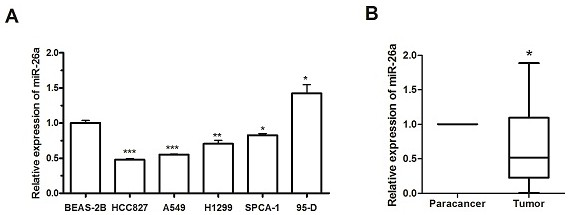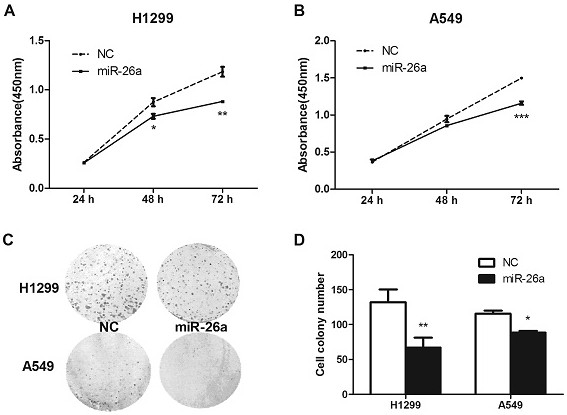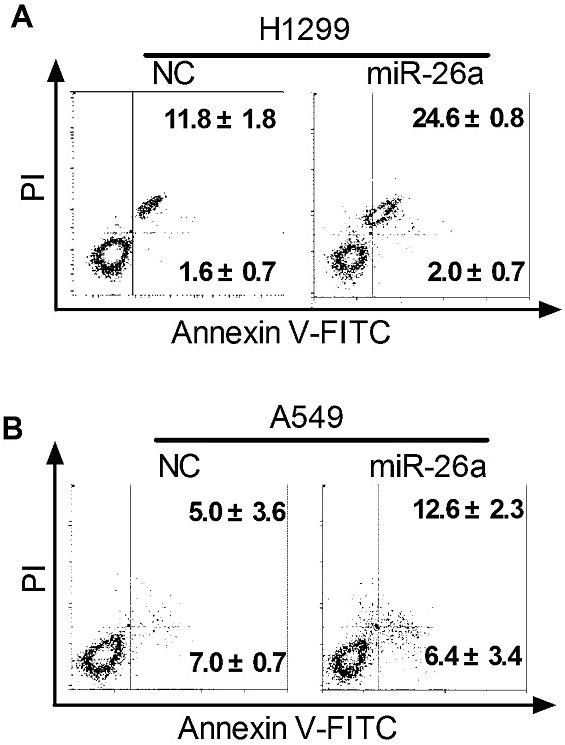Application of mir-26a in non-small cell lung cancer
A mir-26a and gene technology, applied in the application field of miR-26a in non-small cell lung cancer, can solve problems such as abnormal expression and complex function of miR-26a cells
- Summary
- Abstract
- Description
- Claims
- Application Information
AI Technical Summary
Problems solved by technology
Method used
Image
Examples
Embodiment 1
[0036] Example 1: Determining the expression level changes of miR-26a in mouse-induced NSCLC tissues
[0037] The gene mutant mouse lung cancer models (L822T1, L703T2, L903T1) and normal lung cancer model (L1805) used in the present invention were provided by the research group of Professor Ji Hongbin, Institute of Biochemical Cells, Chinese Academy of Sciences. L1805 is mouse normal lung tissue, L703T2 is p53 - / - / Kras + / + malignancy of L903T1 for Lkb1 - / - / Kras + / + malignancy of L822T1 for Kras + / + of benign tumors. The lung tissue of the mouse and the lung tissue of the induced cancer were sampled separately, and the total RNA in the tissue was extracted using the Trizol reagent provided by TaKaRa Company, and the reverse transcription was performed using the One Step PrimeScript miRNA cDNASynthesis Kit (Code No. D350A) of TaKaRa Company , construct the cDNA library of the above tissue, use oligo dt as a primer for reverse transcription, and obtain the miRNA cDNA libra...
Embodiment 2
[0040] Example 2: Study on the expression level changes of miR-26a in human NSCLC cells and tissues
[0041] According to the sequencing results of mouse tumor samples, it can be guessed that miR-26a is a cytokine related to lung cancer. In order to determine whether this conclusion is also applicable to humans, we detected the expression of miR-26a in human lung cancer cells by qRT-PCR. expression levels in the system.
[0042] The cell lines used in the present invention include: HCC827 is EGFR + / + Non-small cell lung cancer cell line, A549 for Kras + / + Non-small cell lung cancer cell line, H1299 for p53 - / - Non-small cell lung cancer cell line, SPCA-1 is an Asian non-small cell lung cancer cell line, 95-D is a human metastatic large cell lung cancer cell line, BEAS-2B is a human lung epithelial cell line. The 24 NSCLC tissue samples and corresponding paracancerous tissues used in the present invention are all from Shanghai Chest Hospital.
[0043] In this example, the T...
Embodiment 3
[0047] Example 3: The effect of miR-26a on the proliferation of NSCLC cells
[0048] The detection of cell proliferation ability was completed using CCK-8 assay and clone formation assay. The specific operation steps are as follows:
[0049] Cell Counting Kit-8 (CCK-8 for short) is a kit for detecting cell proliferation and cytotoxicity developed by DOJINDO, Japan. The specific operation steps of CCK-8 detection are as follows: take the cells in the logarithmic growth phase, seed them in 96-well cell culture plates at a density of 2000 / well, and store them at 37°C, 5% CO 2 cultivated under conditions. At different time points (24, 48, 72, 96 h), 5 µl of CCK-8 solution was added to each well at 37°C, 5% CO 2 After incubation for 1 h, the absorbance at 450 nm was detected using a microplate reader. In order to ensure the reliability of the experiment, three auxiliary holes were set for each group of samples at the same time. In addition, in order to slow down the evaporation...
PUM
 Login to View More
Login to View More Abstract
Description
Claims
Application Information
 Login to View More
Login to View More - R&D
- Intellectual Property
- Life Sciences
- Materials
- Tech Scout
- Unparalleled Data Quality
- Higher Quality Content
- 60% Fewer Hallucinations
Browse by: Latest US Patents, China's latest patents, Technical Efficacy Thesaurus, Application Domain, Technology Topic, Popular Technical Reports.
© 2025 PatSnap. All rights reserved.Legal|Privacy policy|Modern Slavery Act Transparency Statement|Sitemap|About US| Contact US: help@patsnap.com



